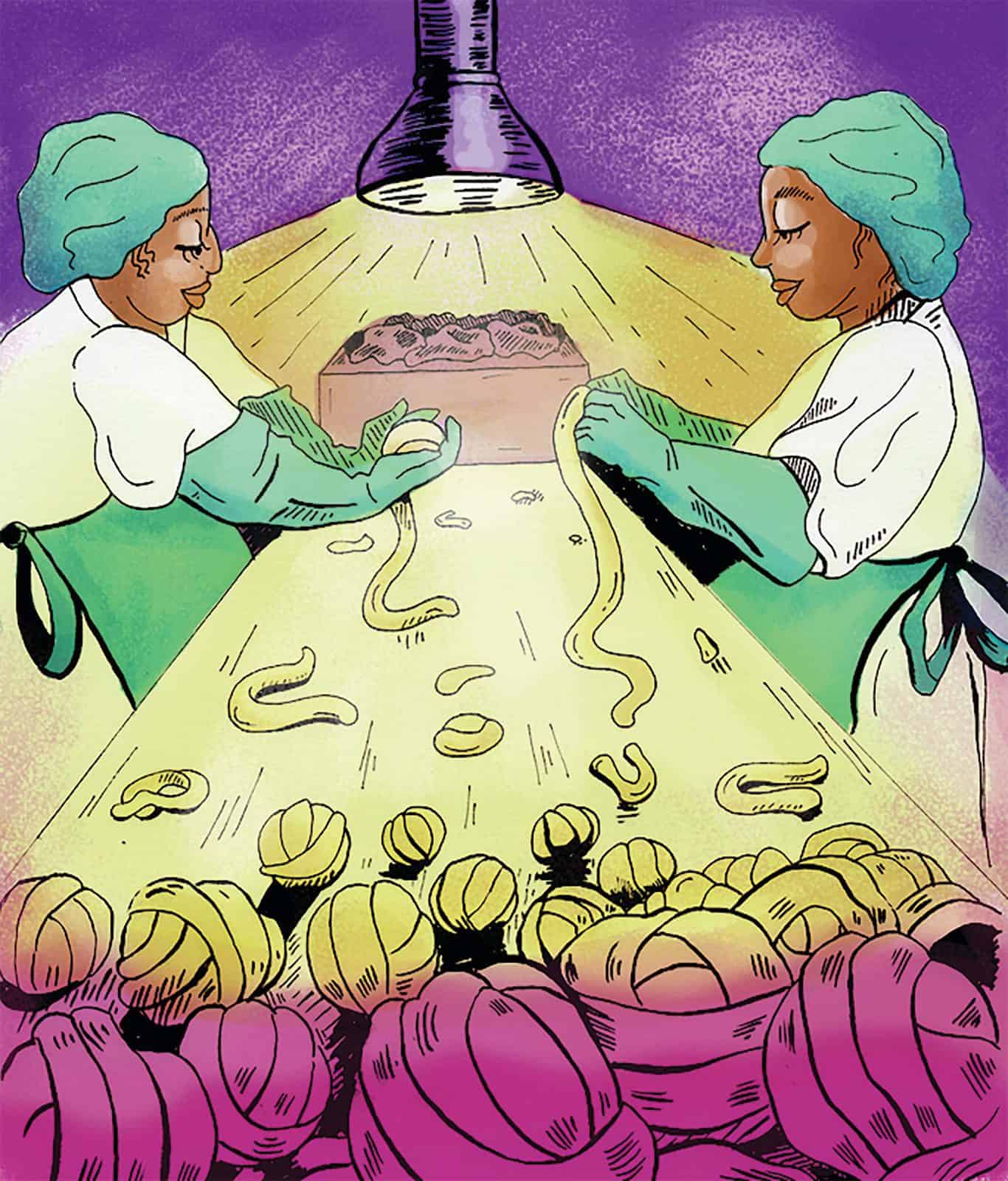
Illustration by Sonic Yonix
Southern Wisconsin’s rolling hills first attracted immigrants from impoverished regions of Switzerland in the mid-19th century. They quickly set about turning rich soil into pasture and, ultimately, cheese. The legacy of Swiss immigration, which continued into the early 1900s, thrives to this day. It fuels the economy, culture, and tourism. Swiss flags hang in town squares, cheese shops in wooden chalets beckon tourists, and yodeling is ubiquitous during Green County Cheese Days, a biennial festival drawing tens of thousands to Monroe, Wisconsin.
But today, a less visible immigrant influence is quietly reshaping the cheese industry here. Wisconsin leads the nation in “Hispanic-style” cheese production, cornering 32 percent of the market. And that market is growing. While these styles account for just 2.5 percent of cheese retail sales nationwide, the segment is growing five times as fast as cheese sales in general.
“It’s booming,” says Jim Crubaugh, who oversees an annual production of about 40 million pounds of cheeses in the categories queso blanco and queso fresco, at Wisconsin Cheese Group’s three plants in the Monroe area. So, who’s eating it all? “We don’t sell a pound of it in Green County,” Crubaugh says. Like most Wisconsin-made Hispanic-style cheeses, including queso quesadilla, cotija, and panela, his products leave the state for grocery shelves and restaurant kitchens in communities with large Latin American populations, from New York to Miami to Houston. The rural Monroe area might have a Latino population of just a few percentage points—but the changing demographics of America have rendered it an epicenter for Hispanic cheese production.
“The quality milk is here,” says Carlos Osorio, a Venezuelan-American, third-generation cheesemaker, and owner of Moundview Dairy in Platteville. Osorio’s grandfather founded Pasteurizadora Táchira in the Andean region of Venezuela in 1956. After arriving in Wisconsin 30 years ago to study engineering, Osorio fell in love with an American whom he later married. He opened Moundview Dairy in the summer of 2018. A year later, the factory is rolling out 100,000 pounds of queso blanco weekly, with room to grow.
Fresh, springy queso blanco is an all-purpose cheese in many Latino households in the US. “It’s always on the table. It’s almost like getting the butter out,” Osorio says.
“Hispanic” is an umbrella term fora diverse market of cheeses that’s “badly understood” in the U.S., Osorio says. Given the sheer size and diversity of Latin America, these cheeses have no standard identity. Puerto Ricans expect queso blanco to look one way, while Mexicans have other expectations. So, cheesemakers tweak levels of salt, moisture, and enzymes—plus shape and branding—according to the market. Part of Osorio’s business model is figuring out where, for example, the Venezuelan immigrants in the US are.“We are chasing the market. We are chasing the Venezuelans,” he says.
John Jaeggi, grandson of a Swiss immigrant to Wisconsin and an expert in Hispanic cheeses at the Center for Dairy Research in Madison, first noticed local cheesemakers switching to Hispanic styles in the 1980s and ’90s; around the same time, he started learning about these cheeses by visiting plants in Mexico and Central America. While at least two other cheese factories in the area (Mexican Cheese Producers and V&V Supremo) were founded by immigrants, most local producers of “Hispanic-style” cheeses, at least at the management level, are white Wisconsinites who previously made European-style cheeses. They often switch after seeing a business opportunity in the large market, plus better margins, higher yield, and quick turnaround.
The transition hasn’t been without challenges. White Americans’ perceptions of what makes a good Hispanic-style cheese aren’t necessarily authentic or what the market wants, Jaeggi says. The milk, methods, and regulations are different in Wisconsin, too. For example, cheesemakers here have had a tough time recreating a Nicaraguan-style hard grating cheese called queso duro. In Nicaragua, queso duro is often made over open fires with raw milk from cows fed fish meal, giving it an “intensely salty, smoky, even fishy” taste, Jaeggi says. Early attempts at queso duro in Wisconsin tasted closer to parmesan. But after experimenting with liquid smoke, enzymes, and cultures, the Center for Dairy Research found a way to make its own interpretation.
Jaeggi adds that an increasing number of white Americans are starting to discover Hispanic cheeses. “One of the biggest growth factors is the Anglo market,” he says. According to Lizzie Duffey, public relations specialist at Dairy Farmers of Wisconsin, a key is to show consumers that there are myriad uses for Latin American–style cheeses beyond melting into a quesadilla, “from the stringiness of queso Oaxaca, to the crumbliness of a queso fresco or aged cotija, to the firmness of a queso blanco that browns when heated but doesn’t melt.”
Osorio sees a possible opening for marketing his queso blanco more broadly as a frying cheese. A slab of it fries up just like a steak—crisp on the outside but still squeaky on the inside. A nearby restaurant and bar, Gracie’s Point, uses Moundview’s queso blanco to make “naked cheese curds,” a twist on Wisconsin fried cheese curds, without the breading.
The Swiss transplants of 150 years ago made this area the cheese hub it is today, passing down skills from generation to generation and priming it for another wave of immigrant influence. At Moundview, plant manager Jake Niffenegger explains how his Swiss grandfather emigrated to this corner of Wisconsin and started turning out wheels of Emmentaler. Niffenegger was stirring curds by age 12. Now, he’s a certified Wisconsin Master Cheesemaker—who makes queso blanco. In the end, “making cheese is making cheese,” he says.



